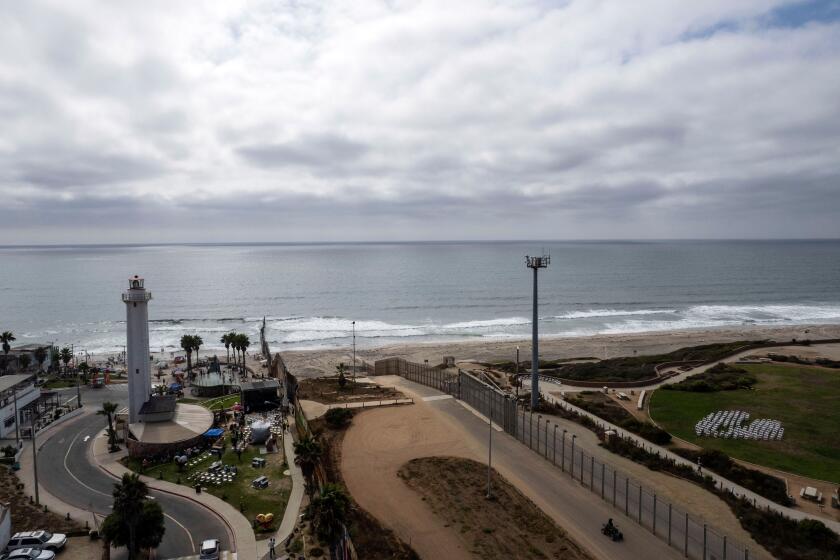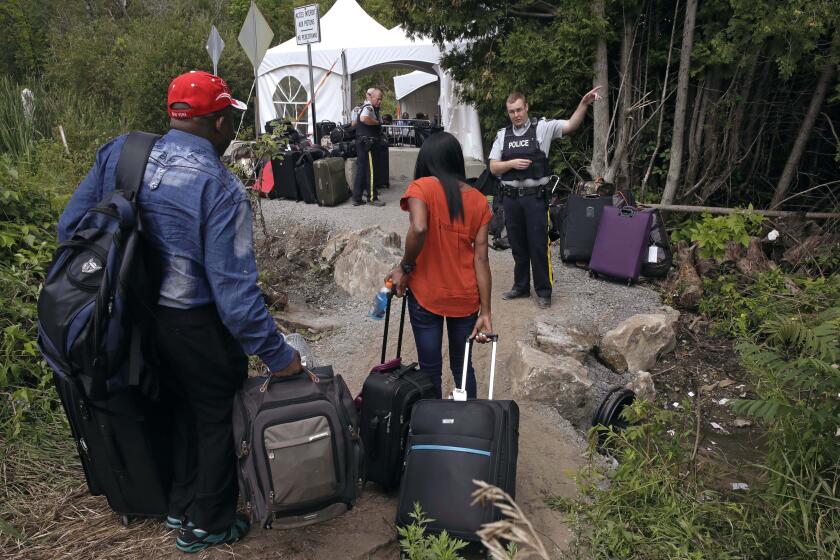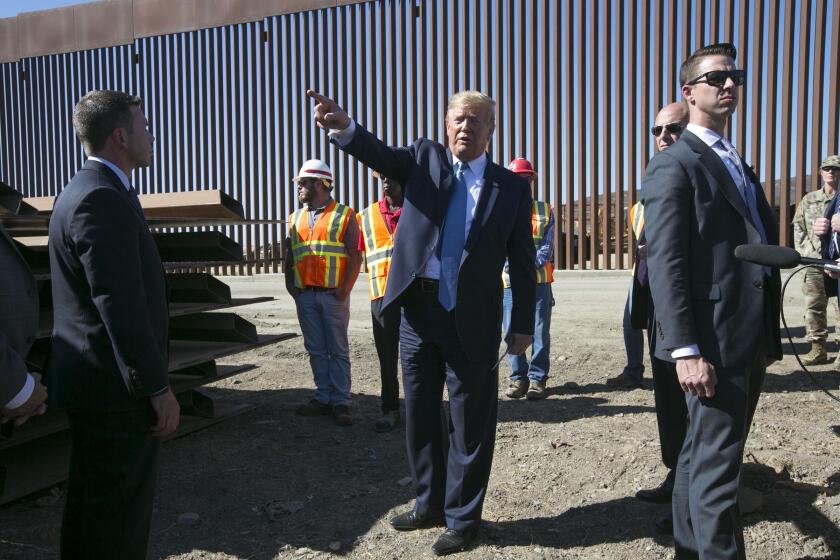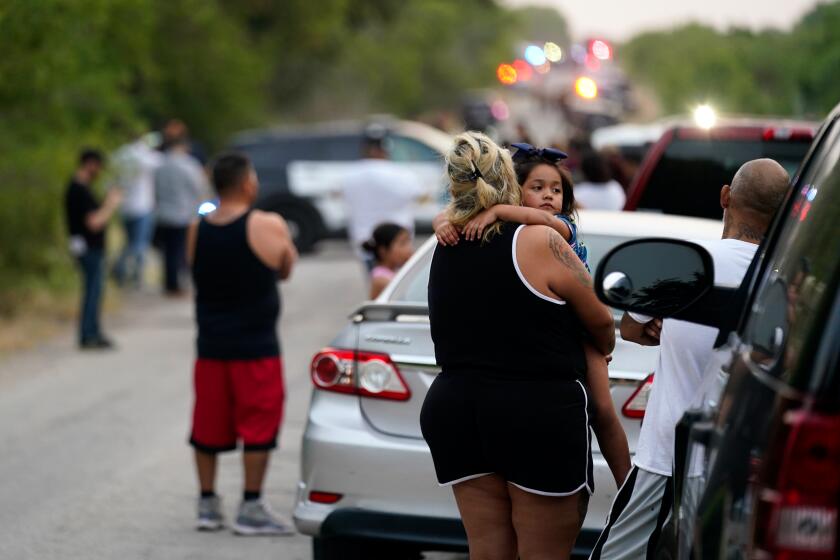As a San Diego neurosurgeon, I see the devastating toll of the raised border wall
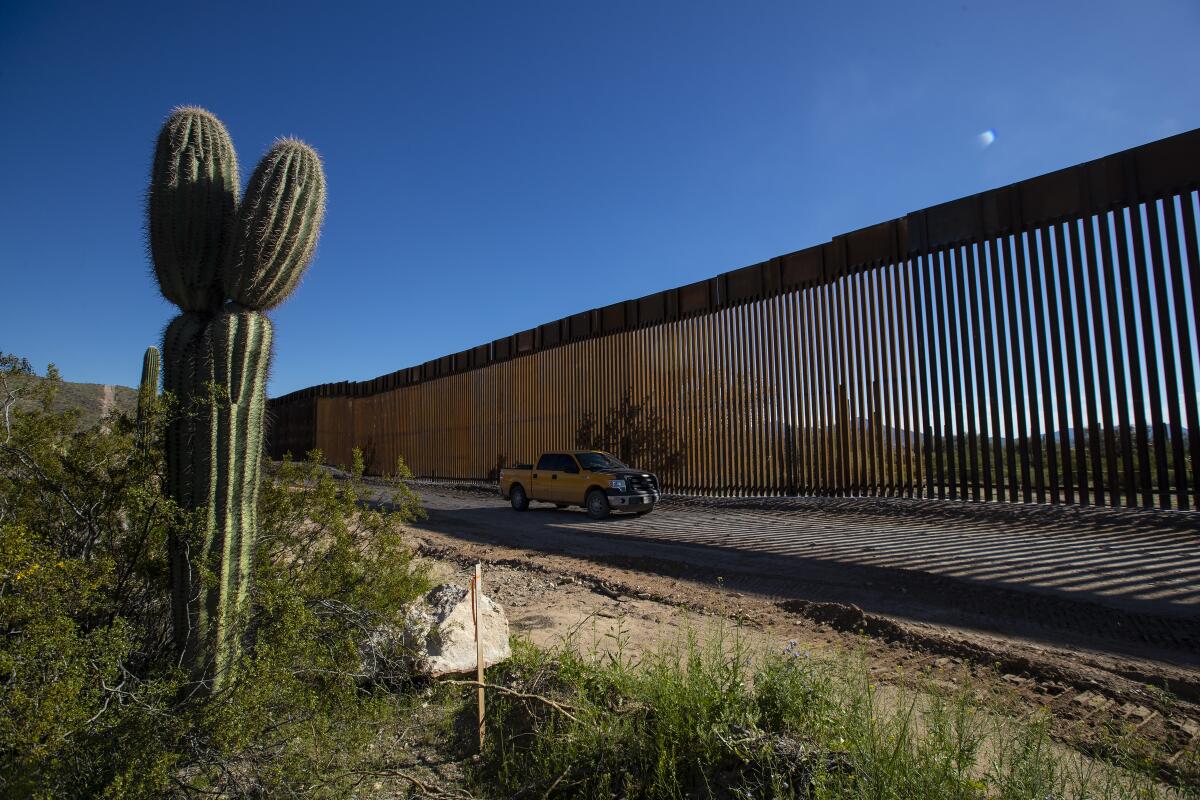
- Share via
At 2 in the morning and while I was caring for my hospitalized patients, my pager went off. The message was short: “30-year-old male. Unstable spinal fracture after border fall.” I think of all the similar pages I have received in my three years as a resident physician in neurosurgery in San Diego: young individuals with life-changing severe injuries that they sustained falling from the wall that separates the United States from Mexico. The Trump administration raised sections of this wall to 30 feet high rather than 8 to 10 feet, after which more falls caused more serious injuries.
Before seeing the patient, I took a moment to look at the MRI: He had a severe spinal cord injury. I walked over to the trauma unit and saw the terrified young man, lying immobile with a collar supporting his neck. Instead of concerned family, he was surrounded by Border Patrol officers. I sensed his despair and then his relief when I spoke to him in Spanish. I told him that we would care for him as best we could, but that he would need surgery. He started to cry. As I examined him to determine the extent of his injuries, checking whether he could feel my hand or wiggle his toes, I asked him to tell me about himself.
He told me why he came: “Ya era muy peligroso para mi y mi familia en el pueblo.” It was too dangerous for me and my family back home.
If the 30-foot-tall steel wall goes up in California, it won’t be Republicans who will be remembered for transforming a once-hopeful place into one of anguish.
This is a story I know all too well. As the son of Mexican immigrants who crossed the same border in the 1980s when fleeing violent threats in their hometown, I know that my patient’s life story could so easily have been mine or my parents’. Raising me in an impoverished migrant community in South Los Angeles, my parents instilled in me the values that I live by, to help the helpless.
When I care for people fleeing similar violence, I know that they are searching for the same things that my parents did and that we all do: safety and a chance for a better life for their children. As a neurosurgeon, I am horrified by the rash of traumatic brain and spinal cord injuries caused by falls from the border wall.
Under Executive Order 13767 in 2017, the Trump administration started raising the height of sections of the border wall in San Diego, Arizona and Texas to as high as 30 feet. The wall in San Diego was completed in 2019. Since then, there have been a record number of traumatic spinal injuries sustained in border falls. The Mexican Consulate recently noted that 646 Mexican nationals were hurt or killed crossing the border from 2020 to 2022, saying the main cause of injury “was wall-related.”
Under last week’s Biden-Trudeau deal, many migrants seeking safety could soon be passed from Canada to the U.S., Mexico and beyond.
As a neurosurgeon working in San Diego, I can attest that we are seeing not only more but also new types of neurological injuries, including traumatic brain and cerebrovascular injuries that will leave people unable to work and care for their families. The horrors we are seeing now are caused by the height of the wall.
Aside from the humanitarian impact, there are economic costs that few anticipated. The cost of caring for each patient injured while crossing the border has increased by 70% since 2020. Our hospital systems, already strained by the COVID-19 pandemic, are now facing a rash of border-wall injuries.
I fear that this trend will worsen in the coming months. The Biden administration initially signed an executive order to halt all funds directed for border wall construction. However, the administration has now approved continuation of these projects in Arizona and Texas. More recently, plans to erect 30-foot barriers at the historic San Diego Friendship Park were approved.
We are now dealing with an international public health crisis.
The news that the former president’s border wall has been breached more than 3,000 times in three years is a reminder of just what a bad idea it was.
To be sure, some will argue that no one should try to cross the border fence in the first place. Consider what would drive someone to take these risks to come to the United States. The patients I care for are not coming here because of trivial circumstances. They are coming because of unlivable political, economic and violent conditions, similar to what my parents endured. They are aware of the dangers the new border walls pose. They just don’t have a better option.
As one of the primary residents taking night call, I can attest to the unnecessary human suffering the higher wall is imposing on people doing what any of us would do if the situation were reversed: seeking safety for themselves and their children.
We must urge political leaders to halt these planned border wall extensions and provide greater resources for hospitals serving border regions. I understand the need for border policies, but increasing the height of a physical barrier is not the answer: We know now that this leads desperate people to risk spinal cord and brain injuries. We must urge both local officials and the Biden administration to recognize these unintended humanitarian and economic consequences of the border walls.
Thousands of desperate migrants have died trying to cross the militarized U.S. border, but U.S. administrations refuse to change border strategies that drive these deaths.
That night with the 30-year-old patient, as I tried to comfort him, he asked: “Cómo voy a cuidar a mi familia?” How will I care for my family?
I think of the line by the Somali British poet Warsan Shire, who wrote: “No one would leave home unless home chased you.” I think of my parents and the sacrifices that they made so that I could become a neurosurgeon. I am grateful that my parents didn’t have to risk these injuries by climbing a 30-foot wall.
However you feel about immigration, ask yourself: Is that risk something you would want for anyone?
Alexander Tenorio is a neurological surgery resident in San Diego.
More to Read
A cure for the common opinion
Get thought-provoking perspectives with our weekly newsletter.
You may occasionally receive promotional content from the Los Angeles Times.
